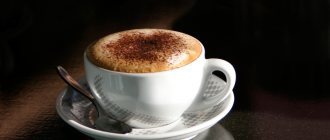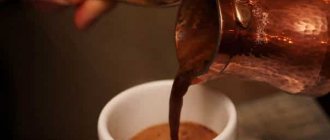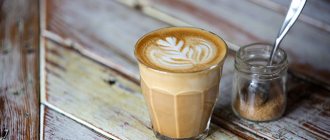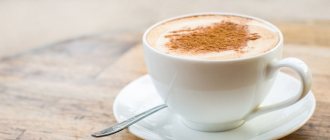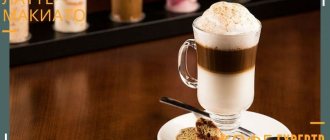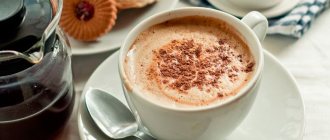Throughout the history of coffee, it has been served in a variety of containers. In past centuries, when the drink was worth its weight in gold, the padishahs drank it from silver cups, similar to modern glasses, and European luxury lovers drank it from deep saucers. Now the ritual of serving the drink has taken common forms in most countries of the world. Each type has its own dishes. Today our focus is on cappuccino cups. How to make the perfect choice and how much will you have to pay for such dishes?
Ingredient proportions
This is the first difference between latte and cappuccino. Despite the fact that both contain milk, coffee and foam, the proportions of the components are different.
- Latte. It contains twice as much milk as coffee or milk foam and is therefore considered an espresso-based cocktail. Half of the composition is heated milk, and the other half is other ingredients.
- Cappuccino. It contains all three components in equal proportions, which is why it is considered a type of coffee.
In other words, their main difference is the concentration of milk, which is lower in the second drink.
Milk foam
Their foam also differs in structure, density and appearance.
- Latte. This is a very gentle and soft drink, and its foam is light and airy. In most cases, its shape resembles a lush dome, which simply allows sugar to pass through itself and is suitable for drawing ornaments. The decoration technique is called latte art. A correctly executed pattern should remain on the surface for 12 minutes, even if everything has already been drunk. The foam with decoration simply settles to the bottom of the glass.
- Cappuccino. The foam is languid and thick, darker in color than a cocktail. If properly whipped, it will even withstand the weight of certain objects. This is easy to check in practice: the foam will not sag under the weight of a spoon or sugar poured onto it, which cannot be said about cocktail foam.
But for both latte and cappuccino, the foam should be completely homogeneous and free of bubbles.
Serving method
Traditionally, lattes and cappuccinos are served using different methods. Knowing what glasses they are poured into and in what volumes they are usually served, it is difficult to make a mistake in your choice.
- Latte. Virtually all coffee cocktails are served in glass glasses and this cocktail is no exception. It is prepared in an Irish glass, which should normally be made of heat-resistant glass. The glass retains its temperature for a long time and it must have a handle. The usual serving is 240-360 ml. Usually served at a temperature of about 70 degrees. In Italy it was drunk during the day, but at the moment there are no time restrictions.
- Cappuccino. This coffee drink is consumed from porcelain cups with a capacity of 180 ml. The walls of the cup are made of thick-walled porcelain, and the inside of the vessel is covered with durable enamel. The cup should be cone-shaped, tapering towards the top. Only in this case, the dense foam covering the drink will be enough for the entire volume of coffee.
Strength and smell
The key difference between these drinks is their taste and smell.
- Latte. The coffee taste is smoothed out by milk. The astringency is virtually not felt, and if sugar is added, it is completely lost. That’s why the taste of this cocktail is considered mild. The smell is very subtle and you can't actually smell the coffee.
- Cappuccino. Thanks to the composition, the strength and smell of coffee is better felt in it. The taste is coffee and more intense with minor milky notes.
Manufacturing methods
The usual production design, both latte and cappuccino, is completely monotonous. But at the moment there are various cooking recipes.
- Latte. From time to time this cocktail is prepared like this. First, whipped milk, heated to 70 degrees, is poured, and then espresso is carefully added to it. This helps achieve a layered effect.
- Cappuccino. It is always prepared using the usual method. Milk is added to the roast espresso and then stirred until smooth.
Conclusions So, you can simply find out what the differences are between these two coffee drinks.
Latte: This is an espresso-based cocktail, half of which is milk. Its foam is light and resembles a dome and can be used for drawing various ornaments on it. Served in Irish glasses. It has a mild taste, smoothed by milk, and a faintly tangible odor.
Cappuccino: This is a coffee option that has a thick, dense foam that can withstand the weight of a spoon or sugar. Served in cups with a wide top. It has a strong taste with notes of milk and a distinctive aroma.
We also recommend reading about the differences between Americano and espresso.
Cappuccino and latte: differences in the manufacturing process and recipes.
Any of us can fully enjoy the fragrant strength of cappuccino and the unique taste of latte. But not everyone thinks that these two drinks are different from each other. If you are not an experienced and specific coffee lover, then it may seem that they are very similar, because in both cases milk and coffee are mixed together. In reality, there are certain subtleties that allow you to create a unique taste for latte and cappuccino coffee.
Differences in manufacturing recipes
The difference between a latte and a cappuccino may seem insignificant, since the ingredients for making it are similar. You need coffee and sugar, milk and toppings, which are added to taste and optional. It should be noted that the development of the production of drinks is different from each other; they have completely different taste, presentation and serving.
The main difference between a latte and a cappuccino is the ratio of coffee, milk and milk foam used to make the tasty drink.
Traditional latte recipe
Please note that latte belongs to the group of milk-based cocktails. The concentration of espresso in the drink is low:
- ? part of the coffee.
- If cream is used to make a drink, then take half the cream and half the milk; otherwise, use 3/5 of the milk.
- 1/5 part milk foam.
Technological map of cappuccino
The concentration of espresso in this drink is significantly higher, which is why it is classified as coffee and not coffee-based cocktails. Includes:
- 1/3 part espresso;
- 1/3 part milk;
- 1/3 part milk foam;
- topping and sugar as desired.
Classic recipe
Making cappuccino coffee at home is not difficult. The process will consist of several steps.
- Making espresso
- Making foam from milk
- Combining coffee with foam
- Decorating the drink with auxiliary ingredients
How to make cappuccino coffee? Next we will consider this issue in detail. Espresso at home can be brewed in a Turk. Espresso coffee ingredients: 125 ml water, 35 g ground beans. For lovers of a strong drink, you can increase the dose of powder to 40-45 g. To feel the energy of the drink, you should bring the liquid to a boil 2-3 times. In this case, the strength of the coffee will increase each time.
It is advisable to prepare foam from full-fat milk (at least 2.4% fat content). Take a hot drink, pour it into a blender or mixer, and beat. If you have a cappuccino maker, the procedure will be much easier. It will take less time to obtain airy foam than to form it using a whisk or any of the above devices. At first, the thought arises that the process is useless, but you must have patience. After a few minutes, large bubbles will appear, then a thick foam with small bubbles will appear. This is exactly the kind of foam you need for cappuccino.
The next step is to “assemble” the drink from the ingredients. To do this, prepare ceramic and porcelain dishes. Rinse the cup with hot water to warm it up. Pour hot espresso into it. The next thing to do is pour milk in a thin stream to form a new layer. And cover everything on top with foam.
You can decorate the cappuccino with a regular design (in the form of a heart, cherry, flowers, apple, inscription, etc.) with or without a stencil. For the image on the foam, cocoa, cinnamon, and chocolate chips are used.
For those who have a sweet tooth, experts advise adding sugar at the end, when the foam is already in the drink.
Difference in cooking process
Despite the similar composition, the development of the production of drinks is very different.
There are several methods you can use to make a latte: latte macchiato and traditional latte. To make the first one, it is recommended to pour previously heated milk or its mixture with cream into a glass, and then add coffee. As for the traditional version, it is prepared like cappuccino, only the proportions are different. Foam can be added before pouring in the espresso or added at the very end. Before this, lattes were not stirred, but sought to achieve a layered structure; now the trend is for a homogeneous drink, so mixing is allowed.- To make cappuccino, pour a portion of coffee into a container, then add milk that has previously undergone the frothing process, and spread the resulting foam on top. It is not customary to stir the drink.
Milk foam structure
Latte foam is characterized by looseness; it is not able to hold even the lightest elements created for decoration on its surface. In a latte, its layer is not very high; it is only a decoration for the coffee cocktail, and not its full-fledged flavor component.
As for cappuccino, the foam in it is more dense, despite the saturation with air. Cocoa or cinnamon powder sprinkled on top, sugar stays on the surface of the film for a long time without settling down. The foam layer should always be the highest.
The foam for making latte is whipped a little less than for cappuccino. To achieve the best results for cappuccino, use milk with a high percentage of fat content.
Differences in the tastes of drinks
Does the development of how drinks are made affect their taste?
Latte has a gentle and creamy milky taste, since it is not as strong as cappuccino. If you don't add sugar to it, it tastes like regular milk. The quality of coffee in this case does not play a very significant role, since its concentration in the drink is low. The foam of the drink is saturated with oxygen, which is why it is loose, light, with a gentle milky taste.
Cappuccino has a distinct coffee taste. Using milk only manages to highlight the aroma of espresso. If you drink it without sugar, you can feel the nutty notes that complement the strong coffee.
The foam is compacted, which has a pronounced milky taste; it can be supplemented with cocoa, cinnamon or chocolate.
What is cappuccino
Several hundred years ago, in an Italian monastery, Capuchin monks invented the first recipe for cappuccino coffee. It was extremely simple, because it consisted only of freshly brewed coffee and a portion of fat goat milk. Since then, many options for preparing the drink have appeared, and in the literature you can find dozens of different recipes that involve the inclusion of a variety of ingredients.
In the classical sense, cappuccino is coffee that consists of 1 part frothed milk, 1 part strong espresso and 1 part fluffy and thick milk foam. Different recipes may contain other ingredients, such as chocolate, vanilla, syrup, sugar and others. There are also many preparation technologies; not only the taste and appearance of the drink, but also the name, depend on them.
The composition of cappuccino coffee may vary depending on the region of preparation. But foamed milk is always and everywhere present, and this is not an easy tribute to the recipe. The thick milk foam covering the espresso layer does not allow the aroma of the drink to dissipate, which means that until the very last sip it will be as rich as freshly prepared. Since milk makes up on average more than half of a serving of cappuccino, and it is taken mainly from fat, the average calorie content of the drink can be 60 kcal per 100 grams. The calorie weight can be reduced if you do not add sugar, or if you prefer low-fat milk, but then you will not get a thick milk foam.
Art latte is an art that originated in Italy, where coffee is best understood.
Not long ago, a new type of culinary art became known to the world - art latte, which involves the highest skill in preparing cappuccino. It's not easy mixing ingredients correctly to get the perfect drink. This is the art of whipping milk and combining it with coffee so that the intended design appears on the surface of the cup, from a lily flower to a fern branch or a funny face. Among baristas, there are only a few specialists who are recognized as the best latte art professionals, because this skill takes years to learn.
The nuances of coffee consumption
The usual approach calls for drinking before noon. Italians are convinced that these are morning drinks because they contain milk. If you familiarize yourself with Russian information channels, there are no strict restrictions, there are only tips.
How to drink a latte:
- Suitable for consumption between meals, as it can be worn out in huge volumes.
- There is not enough caffeine in its composition, so you can drink it even in the evening.
- Usually, a napkin, spoon and straw are served with the glass. We hold the glass with a napkin so as not to burn ourselves, stir the drink with a spoon, and drink with a straw.
- Fruit and curd flavors are in amazing harmony with the taste of latte. Cheesecakes, soufflés and mousses are the perfect addition to the drink.
- The delicate palette of the drink is stunningly complemented by nut-flavored sweets or chocolate ice cream.
- If you prefer low-calorie desserts, it is recommended to pay attention to raspberry sorbet, strawberry pudding or fruit marshmallow.
For cappuccino lovers:
- The composition contains a high concentration of caffeine, so they should complete a light lunch or snack.
- They drink it through foam. The delicate milky flavor helps bring out the unique bitter taste of espresso.
- It is not customary to stir cappuccino; it is a sign of bad taste.
- In order to more fully experience the versatility of the taste, adding sugar to the drink is contraindicated.
- Creamy and chocolate flavors blend amazingly with cappuccino. Buttercream, panna cotta and brownies are perfect.
- If you like to treat yourself to unusual desserts, we recommend that you pay attention to peach mousse or coconut cookies.
- If you have to count calories, then choose meringue or strawberry jelly - desserts that are virtually fat-free.
The history of coffee is very rich. Now this is a trend, as it was many years ago, because every connoisseur is offered a huge number of types of coffee: Americano, mochaccino, glasse, raf and simple instant drinks, for example, coffee white. They are made using different methods, so try and choose.
Making cappuccino in a coffee machine is a new life for your coffee lover.
Popular types of coffee with milk without sugar, with cane sugar and various toppings
Mixing coffee with milk produces different drinks that are quite popular in our coffee shops. These are cappuccino, latte, macchiato, iced latte and others. They differ in different proportions of the main ingredients, cooking techniques and presentation form. Naturally, each product has its own characteristic combination of taste, aroma and strength. Cappuccino retains the aroma and strength of the original espresso, slightly smoothed with milk foam. Latte “sounds” softer, the coffee taste and aroma are felt much weaker, it looks like a layered cocktail. Latte macchiato contains espresso and frothy milk. It is permissible to add nuts, cinnamon, grated chocolate, and your favorite syrup, such as caramel, to the drink. The macchiato has a higher milk content – 100 ml per serving. In combination with sweet fillings, children will especially like it.
History of cappuccino
There are two known versions of the origin of the name cappuccino. Cappuccino in Italian means the name of the monastic order and the reddish-brown color of the monks' robes. Perhaps the color of coffee with cream evoked associations with Capuchins, which is why in the 18th century. in Austria the drink was called Kapuziner. In Italy, the name cappuccino appeared exclusively in the 20th century, but this history of the drink is surrounded by a romantic flair. Capuchin monks in a monastery near Rome were deprived of earthly joys; the only joy was coffee with cream. Experimenting with flavors and proportions, Capuchins learned to decorate a coffee cup with whipped and steamed cream.
But the foam stubbornly settled even after the cream was replaced with milk. The recipe was perfected when a certain Giuseppe made a prototype of a coffee machine that frothed milk using steam. The principle of creating stable milk foam, discovered by the Italian master, is still used to this day, therefore, while enjoying the most delicate cappuccino, remember the inventor Giuseppe with a good word.
Conditions for making cappuccino in a coffee machine
It is very difficult to prepare a real cappuccino without a coffee machine, and when working with a coffee machine, it is necessary to take into account the subtleties of the recipe.
Milk for cappuccino
- Skim milk is not at all suitable for cappuccino - it will not produce a foamy head. An impeccable result can be achieved by using the fattest milk, and even 3.5 percent will be enough for the taste of espresso to emerge and the head of frothed milk not to settle.
- It is also important to take into account the protein content in milk, because the tenderness and thickness of the foam almost entirely depends on this indicator. In order for the foam to acquire an oily structure, the percentage of protein in the drink must be in the range of 2.8 to 3.5. You can whip up foam with any milk, but only high-protein milk produces dry and large bubbles that create a feeling of lightness.
- Excellent foam comes only from cool milk. It is necessary to start whipping at a temperature of +3-5 o C, then there will be enough time to correct possible errors when heating to a critical 75 o C. At a higher temperature, a corresponding taste of boiled milk appears, which should not be in cappuccino. Foam production occurs in two steps: foaming and heating with steam. Both processes must be carried out in compliance with the temperature regime.
- The introduction of stale, dried, protein-free and skim milk is excluded. Pay attention to the expiration date of the packaged product, because for long-term preservation, manufacturers often add powdered milk to the composition. Selecting suitable milk for cappuccino can only be done experimentally.
Video: How to make cappuccino in a Philips Saeco Poemia coffee machine
- All utensils for making and serving cappuccino must be heated to +40 o C.
- Make sure the dishes are clean and there is no water or condensation in the pitcher.
- Cappuccino is served in transparent glass cups, in which the drink looks presentable.
Types of Coffee Cups
You might think that shape doesn't matter, but that's far from true. Containers come in different types and sizes:
- An espresso cup with a thick bottom should keep coffee hot for a long time.
- The latte mug is designed to highlight the beauty and aroma of the airy drink.
- The cappuccino glass should be spacious and roomy.
For espresso
Enterprising Italians have long invented espresso containers. The outer contour of the container may be different, but the inside of the cup should be made in the shape of an egg. The thickened bottom and walls of such a vessel will help preserve the thick foam that is obtained during cooking.
Coffee connoisseurs say that under no circumstances should you take a cup with a square bottom; angular dishes will not be able to keep the drink hot for a long time. The edges of the vessel should be rounded, so the receptors will sense all the notes of taste.
Cups with a volume of 40-64 ml are most often used, the largest size is 70 ml. A standard portion of the drink consists of 30 ml of coffee, sugar and foam, so a larger glassware size is not required.
When cooking in a coffee machine, the bottom of the container gets dirty, so a flat saucer is paired with the cup.
The handle of the cup is small. It is designed for a person to hold it with two fingers.
Demitasse cup
A small coffee cup is called a demitasse. An unusual vessel made in the shape of an egg looks very attractive. Its thick walls are designed to retain the warmth and aroma of the coffee drink. The dishes are suitable for serving oriental coffee, as well as for any type of drink brewed in a Turk or French press. Green tea lovers also prefer a cup of demitasse.
The name is translated from French as “half cup,” but it was not the French who invented the dishes. The miniature cup came to Europe from sunny Turkey. The volume is usually 60-90 ml. Tiny cups retain heat and aroma for a long time.
For cappuccino
The cappuccino container should be spacious. After all, more than half of the volume is occupied by espresso and hot milk, the remaining space belongs to lush foam. Therefore, the most suitable cup volume for cappuccino is from 170 to 220 ml. In order to preserve the unique taste, use dishes made of ceramics or porcelain.
For latte
Latte consists of several layers. Strictly speaking, this is a coffee cocktail, because the drink contains coffee, milk and foam. It is served in transparent containers so that the beauty of the drink can be seen. The tall latte glass features a rounded handle.
The drink can also be served in ceramic or porcelain cups with a volume of 250-320 ml. The latte cup can also be transparent.
Coffee shops often use a glass without a handle.
For Americano
The drink is served in massive tall mugs. A large cup of coffee has long been a symbol of American food service. The traditional method of preparing Americano has not changed over the years:
- A classic portion of espresso (30 ml) is brought to a volume of 120-160 ml using boiling water.
- Then, at the client’s request, cream, syrup or other toppings are added to the mug.
The drink cup follows the egg-shaped shape of an espresso vessel, only its size is much larger. The cup holds 180-200 ml of coffee . The dishes are designed for a classic serving of Americano with cream.
For Frappuccino
Frappuccino is a very large coffee cocktail and is considered not a drink, but a dessert. Therefore, special dessert glasses are used to serve delicacies. This is an impressive size dish that can hold 350-500 ml of drink.
How to make cappuccino in a coffee machine
There are two types of cappuccino coffee machines, most commonly used at home.
Coffee machine with panarello nozzle
An economical option for equipment with a manual cappuccino maker.
Coffee machines of this type are equipped with an iron tube to supply steam under pressure. The panarello nozzle is placed on the steam supply spout of a coffee maker or coffee machine. A mechanical cappuccino machine works like a spray bottle - from the holes at the wide end of the nozzle, steam enters the milk and froths it. How to use a manual frother:
- The first portion of steam contains a lot of water, so it is allowed to come out without panarello. The steam output will be insignificant, but the steam line will be cleared and the milk will be thicker.
- Milk is poured into a pitcher (a special stainless steel jug) or into another container. The pitcher is filled halfway to leave room for the frothed milk.
- The end of the steam tube is immersed one centimeter in milk. The tube should be located against the wall of the dish at an angle of 45°. Steam, interacting with air, forms a lush foam, so there is no need to lower the tube deeper.
- When steam is applied, the milk will begin to increase in volume. The depth of immersion of the steam tube at this step should remain the same; as the volume of foam increases, the pitcher is lowered.
- The warmer the milk becomes, the deeper the steam wand should go. You will soon see that a crater has formed in the milk.
- After closing the steam tap, the cappuccino maker can be removed from the foam.
- By radially moving the vessel and lightly tapping the bottom of the pitcher on the table, the foam is slightly settled until it acquires a glossy shine.
- Espresso is poured into a heated coffee cup, and milk foam from the pitcher is carefully added on top.
If the sugar sprinkled on the foam remains on the surface, the milk cap is cooked correctly. To make it, you can use any utensils whose walls allow you to feel the temperature of the milk with your hand. The pitcher is perfectly adapted to this task. Do not overheat the milk, otherwise the taste will be distorted and the cappuccino will be spoiled. The highest milk temperature is +70 o C. To avoid overheating and splashing of milk, do not lower the panarello to the bottom of the vessel.
Video: Master class on making cappuccino
Coffee machine with auto-cappuccino maker
The general principle of operation of auto-cappuccino makers: a tube is lowered into the vessel, through which milk is drawn into the frothing device, after which the foam is fed into the coffee cup. Some models of coffee machines allow you to adjust the density of the foam. Almost always, a cappuccino maker is an attachment to the end of a steam generator. In coffee machines with an integrated cappuccino maker, a container of milk is placed inside the machine, and the foam flows into the cup from a spout located next to the espresso spout.
This design allows you to get a “puff” cappuccino, in which coffee alternates with frothed milk. Making coffee in a machine with an automatic cappuccino maker is simple - just pour the milk into a special plastic container, put it in the coffee machine and press the appropriate button. There are modifications of cappuccino makers with an outlet tube and with a milk jug.
Automatic cappuccino maker with outlet tube
This type of coffee machine allows you to prepare cappuccino in two steps: coffee and milk foam are prepared separately. A democratic coffee system provides freedom of choice: you can first brew espresso and later cover it with a milk cap, or, on the contrary, fill the cup with foam and carefully pour in the coffee. In this case, you will get a latte macchiato, in which milk foam is placed on the bottom of the cup and on top, and between them is fragrant espresso. The only difficulty in working with such devices is that you need to wait until the machine cools down a little after the steam is supplied. Many modern cappuccino coffee machines do not have this drawback, because they are equipped with 2 separate boilers, allowing you to simultaneously switch to making espresso. Cappuccino makers with a tube are significantly cheaper than devices with a jug, but it takes longer to make a drink. The main drawback of these models is the need to rearrange the cup and the unregulated density of the milk foam. Another inconvenience is the relative difficulty of cleaning the outlet tube. All cappuccino makers need constant cleaning, otherwise the milk may turn sour, and the appearance of a dirty coffee machine does not inspire the desire to drink coffee.
Automatic cappuccino maker with milk jug
The most “advanced” cappuccino coffee machines are equipped with a milk jug. The device whips milk amazingly and quickly, and at the same time you can choose the density of the foam. Cappuccino and latte macchiato can be prepared “in one touch” - you place a cup into which milk foam first flows, and then espresso is poured out. Many coffee machines with a carafe cannot prepare a cappuccino in the usual way: first they froth the foam and then add the coffee later. True, the foam floats to the surface during this operation, but if you prefer the natural course of events, you will have to press the button twice - first prepare espresso, and then cover it with wonderful milk foam.
The most modern and expensive coffee machines include autonomous control of the cappuccino maker. Menu options allow you to determine the amount of coffee per serving, the volume of milk and whipped foam. You can save your favorite characteristics in the settings and train the coffee machine to start with making espresso and finish the process by adding foam.
Elegant, compact and easy-to-use coffee machines from the best manufacturers will decorate any interior and will always delight you with your favorite coffee: cappuccino, latte, Americano or espresso. Universal coffee machines are equipped with large water reservoirs, operate virtually silently, whip up good foam and do not require effort when cleaning the machine.
Milk in coffee: how much milk is needed in cappuccino and latte?
1 August 2021, 11:18
In every small town there is always a huge number of comfortable cafes where you can drink coffee with milk, cream, syrups or ice. Drinks such as cappuccino and latte are especially popular. To make them, you need to whip hot milk until foamy and add it to coffee. The main difference is in the proportions and serving features, which significantly change the taste properties of the finished drink.
Recipes for making cappuccino at home
Cappuccino is a drink that originated in the 17th century in Italy. It is believed that it owes its name to the order of Capuchin monks. They wore a brown robe that resembled the shade of coffee.
You can enjoy the mild taste of cappuccino not only in a restaurant - you can also prepare cappuccino at home (without a coffee machine or special milk frothing devices). But you need to understand that the taste of the drink will depend on the quality of the ingredients. It is important to get good coffee. As for milk, it should be full-fat - this is the only way to count on lush, persistent foam.
There are different types of cappuccino, with some recipes dating back centuries.
Classic cappuccino in a coffee machine
Using a coffee machine, this drink is prepared simply and quickly. List of ingredients:
- a shot of espresso (if you can’t drink caffeine, you can take decaf);
- 50 mg milk.
Coffee machines are equipped with a special cappuccino maker - this is a nozzle that is immersed in a container of milk and releases steam under pressure. Thanks to the hot steam, the milk is heated and whipped until foamy.
Experts recommend pouring coffee only into warmed mugs (that’s why coffee cups in restaurants are kept on a special stand above the coffee machine - this way they are always warm).
Coffee needs to be poured with milk so that the foam is located on top - the correct cappuccino is divided into layers.
How to make it without a coffee maker
Not everyone has a coffee machine or coffee maker. But in order to properly prepare cappuccino, you don’t need expensive household appliances.
The main ingredient is strong espresso coffee. And it can be brewed in a French press, Turk or small saucepan. The main thing is to strain the drink after brewing.
Milk can also be frothed without a cappuccino maker. The same French press, immersion or stationary blender is suitable for this. You can even achieve the appearance of foam using a whisk, but this procedure will take longer.
Double
If the standard amount of drink is not enough for you, you can make a double cappuccino. In restaurants, it is made using 2 times more coffee: 50-60 ml of espresso is poured with whipped milk (about 100 ml).
For serving, special tall glass glasses with a handle are used. The layers of the drink should not be mixed - this way it looks aesthetically more attractive.
Traditional
In order to prepare a traditional cappuccino, you first need to brew strong coffee (in a Turk or saucepan), then strain and pour into a warm cup.
We also heat the milk to 60-70 degrees, then beat it with a mixer or blender until foamy and carefully pour it into a mug. In most cases, to prepare 1 serving of drink you will need 30-40 ml of coffee and 50-100 ml of milk.
View this post on Instagram
It’s easy to make cappuccino at home without using a cappuccino maker and without having a coffee machine! I make this cappuccino every morning and it literally takes 10 minutes. You need:

